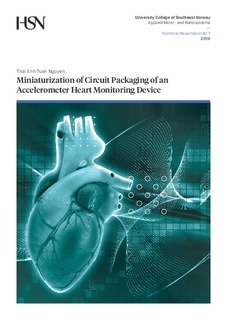| dc.contributor.author | Nguyen, Thai Anh Tuan | |
| dc.date.accessioned | 2016-11-09T14:31:53Z | |
| dc.date.available | 2016-11-09T14:31:53Z | |
| dc.date.issued | 2016 | |
| dc.identifier.isbn | 978-82-7860-284-3 | |
| dc.identifier.issn | 2464-2843 | |
| dc.identifier.uri | http://hdl.handle.net/11250/2420355 | |
| dc.description.abstract | Continuous monitoring heart activity based on implantable accelerometer devices have been demonstrated as efficient method that could provide higher sensitivity and specificity than the conventional electrocardiography (ECG) method. The method can be specified for detection of ischemia on patient who has undergone Coronary Artery Bypass Graft (CABG) surgery. The current implantable accelerometer devices are sutured to the heart surface and have to be removed before closing the patient’s chest since the device dimension is not suitable for closed chest implantation. According to a surgical point of view, a heart muscle implantable accelerometer device can properly present the heart motion without interfering with surrounding organs. The device can be suitable for both intraoperative and postoperative monitoring procedures. However, the heart muscle implantation requires miniaturization of the device to provide minimal tissue trauma and simple implantation procedure.
This study focuses on development of a MEMSbased 3-axis heart muscle implantable accelerometer device. The device is to be implanted into the heart muscle, remain in place after the thorax is closed, and be pulled out though an opening in chest wall after a few days when the intensive care is no longer needed.
Five different versions of the heart muscle implantable accelerometer device were proposed and developed with regards to the prerequisites for the heart implantable medical devices including the regulatory compliances, and the clinical demands and the requirements of device components. These devices were categorised into two main groups built on two different commercial accelerometer sensors. In comparison to the earlier implantable accelerometer device, the dimensions of these five versions were significantly reduced in this study. The overall diameter of earlier device was 11 mm which was far different from the 3.2mmdiameter of the first version device and 2.0mmdiameter of the fifth version.
A novel structure of heart muscle implantable accelerometer device was first conducted in the second version device which has been able to corporate with the pacing/sensing functionality as a temporary pacing wire. This study also suggested specific experimental set-ups for qualifying essential safety requirements (e. g. leakage current, tensile strength, flexural endurance, insulation strength) based on the standards and regulation for the implantable devices. Tests of the complete devices showed leakage currents are at least 1000 times less than the limit for heart implantable applications. This study also pointed out that the pulling strength of a device is important for accomplishing the implantation and removal of the device. Different versions of device provided different pulling strength which varied from 12N up to 100N. The muscle-implantation stability of different versions were demonstrated in this study depend on the device dimension, encapsulation structure, cable flexibility and the implantation method. The implantation procedures of different device versions and quality of the acceleration signals were verified and validated in several animal trials reported in detail in this study | nb_NO |
| dc.language.iso | eng | nb_NO |
| dc.publisher | University college of Southeast Norway | nb_NO |
| dc.relation.ispartofseries | Doctoral dissertations at the University College of Southeast Norway;7 | |
| dc.relation.haspart | P1: Nguyen, A.-T., Tjulkins, F., Aasmundtveit, K., Hoivik, N., Hoff, L., & Imenes, K. (2015). Miniaturization of package for an implantable heart monitoring device. Micro- and Nanosystems Information Storage and Processing Systems, 21(9), 1813-1826. doi: 10.1007/s00542-014-2216-6 | nb_NO |
| dc.relation.haspart | P2: Nguyen, A.-T. T., Tjulkins, F., Aasmundtveit, K. E., Hoivik, N., Hoff, L., Grymyr, O.-J., . . . Imenes, K. (2015). Development of a Multifunctional Implantable Heart Monitoring Device. Journal of Microelectronics and Electronic Packaging, 12(4), 171-180. doi: 10.4071/imaps.476 | nb_NO |
| dc.relation.haspart | P3: Nguyen, T. A. T., Tjulkins, F., Aasmundtveit, K. E., Hoivik, N., Hoff, L., Grymyr, O.-J., . . . Imenes, K. (Unpublished). Performance Improvements of aMyocardial Implantable Heart Monitoring Device. (In preparation for submission) | nb_NO |
| dc.relation.haspart | P4: Nguyen, A. T. T., Tjulkins, F., Aasmundtveit, K. E., Hoivik, N., Hoff, L., & Imenes, K. (2013, 16-18 April 2013). Miniaturization of package for an implantable heart monitoring device. Paper presented at the Design, Test, Integration and Packaging of MEMS/MOEMS (DTIP), 2013 Symposium on. | nb_NO |
| dc.relation.haspart | P5: Nguyen, A. T. T., Tjulkins, F., Knut, E., Aasmundtveit, Hoivik, N., Hoff, L., . . . Imenes, K. (2014, 1-4 April 2014). Packaging of a multifunctional implantable heart monitoring device. Paper presented at the 2014 Symposium on Design, Test, Integration and Packaging of MEMS/MOEMS (DTIP). | nb_NO |
| dc.subject | Heart monitoring devices | nb_NO |
| dc.title | Miniaturization of Circuit Packaging of an Accelerometer Heart Monitoring Device | nb_NO |
| dc.type | Doctoral thesis | nb_NO |
| dc.subject.nsi | VDP::Technology: 500::Nanotechnology: 630 | nb_NO |
| dc.source.pagenumber | 159 s. | nb_NO |
